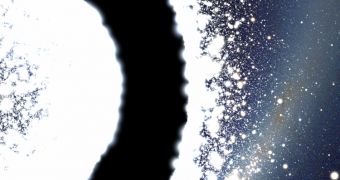Surely an entry must have an exit; there is no doubt about that. Black holes swallow huge amounts of matter as they travel through space, but where does all that material go? One thing is for certain, it can't stay inside it for a indefinite amount of time, otherwise we probably wouldn't be here right now. Therefore, astrophysicists invented the concept of white hole.
Basically, a white hole represents the time reversal of a black hole, meaning that material absorbed by a particular black hole in the past is ejected through the event horizon of a white hole. Don't ask me why they called it a white hole, because it's clearly anything but white. In fact, theoretical models of such objects predict that black holes and white holes cannot be distinguished from one another, as they look mostly the same.
According to the Theory of General Relativity, the acceleration force is invariant under time reversal conditions, thus both the black holes and the white holes have powerful gravitational fields which attract matter, and however they are differentiated by their behavior at the event horizon. While black holes swallow material, white holes eject it. World famous physicist Stephen Hawking, often called the successor of Albert Einstein, argue that if the quantum effects are taken into consideration these seemingly different objects are actually one and the same.
Matter drawn towards the white hole can never cross its event horizon, as the previous recedes from it at local speed of light. Any infilling matter which previously crossed the event horizon is ejected towards infinity after it approached the point-like singularity at an infinitely small distance, as the white hole is being destroyed.
Black holes were first predicted only a few days after Einstein released the Theory of General Relativity by German physicist and astronomer Karl Schwarzschild as a solution to Einstein's field equations, while trying to calculate how massive a object must be before the gravitational acceleration on its surface exceeds the speed of light. Sadly after publishing his work, Schwartzschild died in the First World War while serving in the German Army.
Schwartzschild's solution to Einstein's field equations also predicts the possibility of faster than light travel through Schwartzschild wormholes. Material drawn in by a black hole may travel through a wormhole structure and emerge in another part of the universe through a white hole. Nevertheless, such wormhole has been proven to be extremely unstable, disconnecting between the two massive objects as fast as it forms. Furthermore, the second law of thermodynamic strictly forbids such actions.
Some astronomers even suggested the white holes might be responsible for the Big Bang event, more that 13.7 billion years ago which created the universe. Such types of white holes fed from a higher parent universe would be completely different from the traditional view of a white hole through the fact that it cannot be localized in space and its event horizon would surround a volume equal to that of the visible universe.

 14 DAY TRIAL //
14 DAY TRIAL //